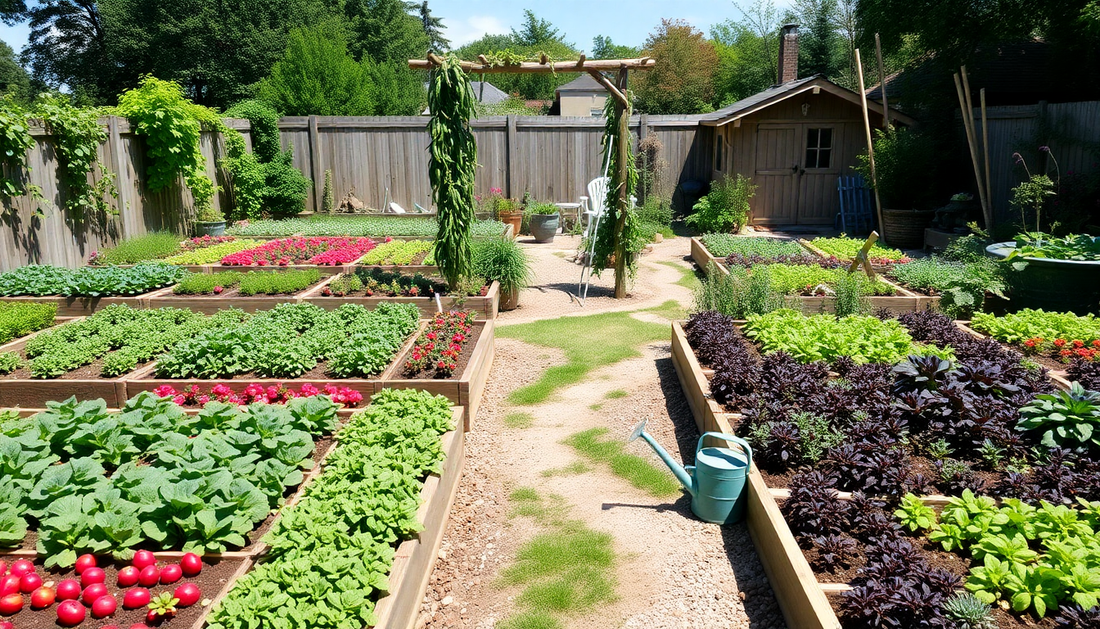
Designing the Perfect Vegetable Garden Layout: A Step-by-Step Guide
Share
As the sun rises on a new year, many of us are eager to get our hands dirty and start planning our vegetable gardens. Whether you're a seasoned green thumb or a budding gardener, the key to a bountiful harvest lies in the layout of your garden. In this comprehensive guide, we'll explore the art of designing an efficient and visually appealing vegetable garden layout that will maximize your yields and bring joy to your outdoor space.
Understanding the Basics of Vegetable Garden Planning
Before we dive into the specifics of layout design, it's essential to understand the fundamental principles of vegetable gardening. The first step is to assess your available space, whether it's a sprawling backyard or a cozy balcony. Measure the area and consider the amount of sunlight it receives throughout the day, as different vegetables have varying light requirements.
Next, decide on the types of vegetables you'd like to grow. Consider factors such as your climate, personal preferences, and the nutritional needs of your household. Once you've made your selections, it's time to start planning the layout.
Laying Out the Garden: Maximizing Space and Efficiency
One of the key aspects of a successful vegetable garden layout is efficient use of space. By carefully arranging your plants, you can create a visually appealing design while also maximizing your yields. Here are some tips to help you get started:
Raised Beds and Pathways
Raised garden beds are a popular choice for vegetable gardening, as they allow for better drainage, improved soil quality, and easier access for maintenance. When planning your layout, consider the size and shape of your raised beds, leaving enough space between them for walkways. This will not only make it easier to move around your garden but also prevent soil compaction.
Companion Planting
Companion planting is the practice of growing different plants together, as they can benefit each other in various ways. For example, planting marigolds alongside your tomatoes can help repel pests, while lettuce and radishes can be grown together, as the fast-growing radishes will loosen the soil for the slower-growing lettuce. Incorporate companion planting into your layout to create a harmonious and productive garden.
Vertical Gardening
If you're working with limited space, consider incorporating vertical gardening techniques into your layout. Trellises, cages, and other support structures can be used to grow vining crops, such as cucumbers, beans, and tomatoes, upwards, freeing up valuable ground space for other vegetables.
Crop Rotation
Crop rotation is an essential practice in vegetable gardening, as it helps to maintain soil fertility and prevent the buildup of pests and diseases. When planning your layout, group your vegetables into families and rotate them annually to different sections of the garden.
Succession Planting
Succession planting involves sowing seeds or transplanting seedlings at different intervals, ensuring a continuous harvest throughout the growing season. This can be achieved by planting early, mid, and late-season varieties of the same crop, or by interplanting fast-growing crops with slower-growing ones.
Designing for Visual Appeal
While functionality is the primary goal of a vegetable garden layout, it's also important to consider the aesthetic appeal of your outdoor space. By incorporating design elements, you can create a visually stunning garden that not only produces an abundance of fresh produce but also serves as a beautiful and inviting oasis.
Symmetry and Patterns
Symmetrical layouts, such as grid patterns or radial designs, can create a sense of order and balance in your garden. Experiment with different shapes and arrangements to find a layout that suits your personal style and the size of your space.
Focal Points and Pathways
Incorporate focal points, such as a decorative trellis, a birdbath, or a small seating area, to draw the eye and create a sense of cohesion. Additionally, well-defined pathways can guide visitors through your garden and add to the overall aesthetic.
Color and Texture
Use a variety of colors and textures in your vegetable garden to create visual interest. Plant flowers, herbs, and ornamental foliage alongside your vegetables to add pops of color and contrast.
Maintenance and Ongoing Care
Designing the perfect vegetable garden layout is just the beginning. Maintaining and caring for your garden is essential to ensure a bountiful harvest and a thriving outdoor space. Here are some tips to keep your garden in top shape:
Weed Management
Regularly removing weeds from your garden will prevent them from competing with your vegetables for nutrients, water, and sunlight. Incorporate mulch around your plants to suppress weed growth and retain moisture.
Pest and Disease Control
Vigilantly monitor your garden for signs of pests or disease, and take appropriate action to address any issues. Consider using organic pest control methods, such as introducing beneficial insects or using natural repellents.
Watering and Fertilizing
Establish a consistent watering schedule, adjusting as needed based on weather conditions and plant needs. Supplement your soil with organic fertilizers or compost to maintain nutrient levels and support healthy plant growth.
Ongoing Maintenance
Regularly maintain your garden by pruning, staking, and trellising your plants as needed. This will not only keep your garden looking tidy but also promote optimal growth and production.
By following these principles and incorporating your personal style, you can create a vegetable garden layout that is both functional and visually stunning. Remember, gardening is a journey, and with each passing season, you'll gain valuable experience and refine your techniques to achieve the bountiful harvest of your dreams. Happy gardening!
